Anigrand 1/144 P.1185 Supersonic Harrier
|
KIT #: |
AA4036 |
|
PRICE: |
$88.00 SRP |
|
DECALS: |
One option |
|
REVIEWER: |
Richard F |
|
NOTES: |
Kit also
includes a Nimrod, Merling and Islander. Resin |
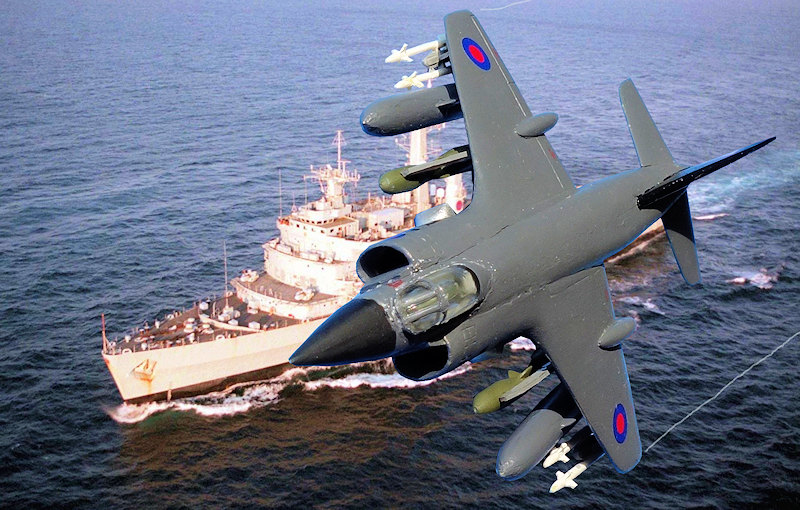
As defence budgets tightened through the 1970s, the Royal Navy realised it
was not going to get a replacement for its carriers like Ark Royal and
Victorious. The RAF's Harrier was being converted into a carrier version to
fly off the so-called "through deck cruisers", but they were still subsonic
aircraft with no BVR capability, and the ships were too small to fly big
jets like Phantoms. Together with the Americans, the British looked at ways
to get more out of the Harrier, while maintaining its excellent VSTOL
capabilities which made small carriers practical for their needs. The design
was the P.1185, known also as the AV-16.*
The Super Harrier won the contract for the next stage of the Sea Harrier,
defeating the subsonic FA.2 proposal. It entered British service too late
for the Falklands war but served in the first Gulf War, primarily in the
close support role. It was well-liked for its dash speed and decent payload,
acceptable range with
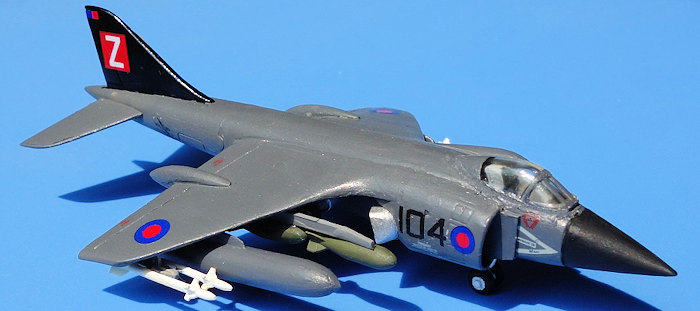 drop
tanks, and ability to defend itself in a pinch with four AIM-9s but no
cannon. The capability to self-designate smart weapons was never integrated
into the aircraft, mainly for cost reasons but also because the distinctive
under-fuselage inlet door, which allowed VTOL and supersonic performance in
the same airframe, meant that the underbelly was not available to carry
stores (and for the same reason, it had no cannon). As a result, the
aircraft began to be of limited use in close air support after the Gulf War,
because of increasing concerns about the risk of civilian casualties. For
this reason, it only flew "No Fly Zone" missions during operations over the
former Yugoslavia in the late 1990s. Super Harriers shot down two Serbian
fighters; one was hit by a SAM. A flight of Super Harriers was detached to
support UK operations in Afghanistan in 2002, but the inability to
self-designate smart weapons and the lack of a gun quickly saw the type's
withdrawal from that theatre.
drop
tanks, and ability to defend itself in a pinch with four AIM-9s but no
cannon. The capability to self-designate smart weapons was never integrated
into the aircraft, mainly for cost reasons but also because the distinctive
under-fuselage inlet door, which allowed VTOL and supersonic performance in
the same airframe, meant that the underbelly was not available to carry
stores (and for the same reason, it had no cannon). As a result, the
aircraft began to be of limited use in close air support after the Gulf War,
because of increasing concerns about the risk of civilian casualties. For
this reason, it only flew "No Fly Zone" missions during operations over the
former Yugoslavia in the late 1990s. Super Harriers shot down two Serbian
fighters; one was hit by a SAM. A flight of Super Harriers was detached to
support UK operations in Afghanistan in 2002, but the inability to
self-designate smart weapons and the lack of a gun quickly saw the type's
withdrawal from that theatre.
The Supersonic Harriers were abruptly phased out of Royal Navy
service in 2006 despite the airframes being sound. Rather than upgrade its
radar and systems, the planes were retired pending the arrival of the F-35
at some increasingly unclear point in the future. As a result, the Royal
Navy had no fixed wing aircraft on its carriers and made no further air
contribution to UK military operations over Syria, Iraq, Libya and, in 2016,
the South China Sea.
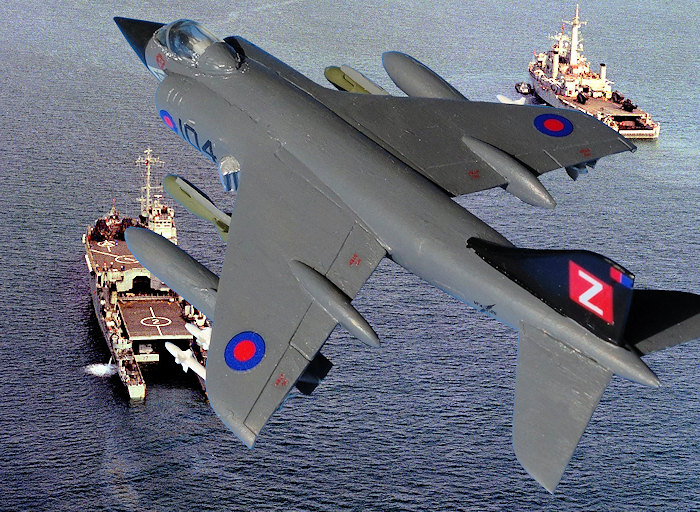 This
aircraft is depicted in its Gulf War era close-support fit. In 1991, Supers
flown by No. 810 NAS were given the Z tail code as a subtle recognition to
the 1956 Suez operations flown by No. 810 Squadron. Because of the need for
cross-decking with US carriers, the warning labels for the jet intakes were
required to be added. The Royal Navy crewmen who applied them put them on
backwards, as there was no room in the customary space aft of the intakes.
As a result, the US crew zapped this aircraft on the rear fuselage.
This
aircraft is depicted in its Gulf War era close-support fit. In 1991, Supers
flown by No. 810 NAS were given the Z tail code as a subtle recognition to
the 1956 Suez operations flown by No. 810 Squadron. Because of the need for
cross-decking with US carriers, the warning labels for the jet intakes were
required to be added. The Royal Navy crewmen who applied them put them on
backwards, as there was no room in the customary space aft of the intakes.
As a result, the US crew zapped this aircraft on the rear fuselage.
Generally, Super Harriers flying close support carried four normal bombs on
the inner pylons, line abreast because there was insufficient clearance from
the side-mounted exhausts, a pair of fuel tanks and then, if needed, twin
launchers for AIM-9s on the outboard pylons.
*Everything after this is not true. The P.1185
was a paper study only. The Sea Harrier FRS.1 was upgraded to the FA.2 which
could fire AMRAAMs, served over Yugoslavia, but remained subsonic.
Don't freak out about the $88 price tag - this is a bonus kit which
comes with Anigrand's 1/144 Nimrod MR2. You also get a Merlin HC.3 and a
Britten Norman Islander Defender. See my preview right
here on MM: .
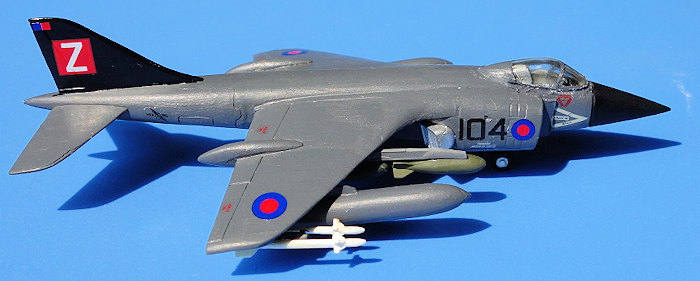 This is
moulded very cleanly in yellow resin with engraved panel lines similar to
what you'd find in a recent Airfix kit - a bit much for some but ok by me.
The small details are nicely done, especially the underwing stores. The twin
Sidewinder rails are really a work of art, very delicate with nice thin
fins. There are also two fuel tanks and two so-called Red Top missiles, one
for each inboard pylon. Just why there are Red Tops is a bit of mystery, as
these were already pretty ancient by the 1980s when the P.1185 study was
underway. Postscript: later I realised that it was only the instructions
that call these Red Tops. I think they are maybe meant to be Harpoons,
though they are way too short. Or something else, perhaps?
This is
moulded very cleanly in yellow resin with engraved panel lines similar to
what you'd find in a recent Airfix kit - a bit much for some but ok by me.
The small details are nicely done, especially the underwing stores. The twin
Sidewinder rails are really a work of art, very delicate with nice thin
fins. There are also two fuel tanks and two so-called Red Top missiles, one
for each inboard pylon. Just why there are Red Tops is a bit of mystery, as
these were already pretty ancient by the 1980s when the P.1185 study was
underway. Postscript: later I realised that it was only the instructions
that call these Red Tops. I think they are maybe meant to be Harpoons,
though they are way too short. Or something else, perhaps?
I was a bit disappointed when I put this together because it wasn't
nearly as neatly fitting as the
Defender I built first from this combo set (you can see
that review here on MM or the Merlin (review
here). The resin itself was okay, with no obvious
blemishes, but the fit was poor. I had to use a fair bit of filler on the
top fuselage seam, and some below too. There were also gaps in the wing
root, and the nose cone needed quite a bit of sanding to deal with the poor
alignment. Tamiya filler worked ok, though I need two applications to really
fill the gap.
I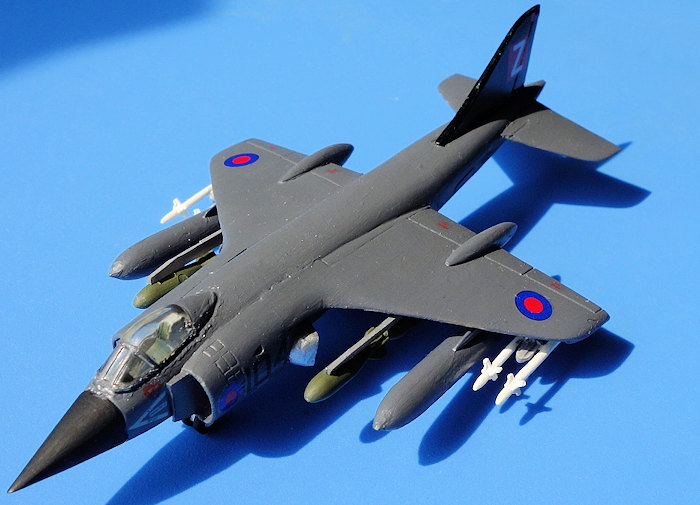 t's a
small aircraft with minimal parts.
t's a
small aircraft with minimal parts.
The underwing pylons were a bit troublesome and if you look
carefully you can see the fuel tanks aren't aligned as well as they might
be. The two twin-launcher Sidewinder rails and missiles are single-piece
items that come with the kit. The bomb pylons inboard are scratchbuilt,
using bombs from some other 1/144 kit I had.
The canopy is reasonably clear, considering it's resin, but the fit isn't
perfect. I used a bit (a lot) of filler here, too. Please remember this is
very small and close-up photos are very unforgiving. The undercarriage is
surprisingly easy to manage. One tricky bit with Harrier builds, or any
other plane with outrigger undercarriage, is to get everything aligned so
the plane doesn't sit lopsided. To do this I added the outriggers and nose
wheel first, and then very carefully trimmed the centerline main gear to sit
at precisely the correct length. It was easier than it sounds.
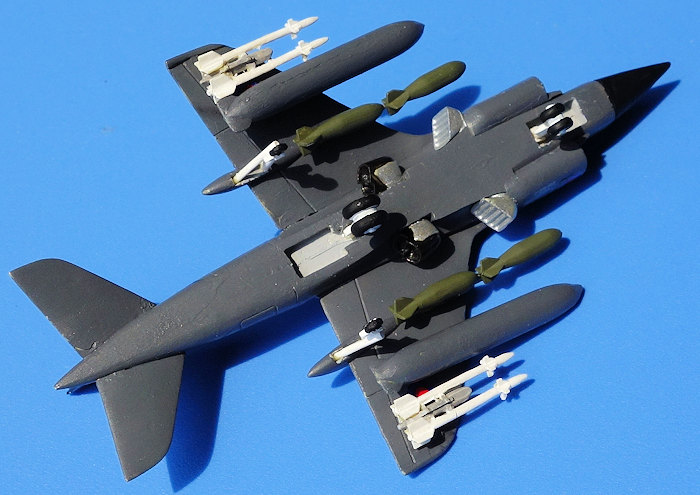 Well,
this is a whiffer, really, so I had to make up my own scheme. Actually I had
more suitable decals for an American version, but to me the Harrier is a
British plane, and therefore I wanted to try for a Fleet Air Arm look. What
colours to use? Extra dark sea grey looks cooler to me than the grey the RN
used on its FA.2 Harriers so I went with that, using enamels from Gunze. It
stuck happily to the resin. For a bit of colour I painted the tail
semi-gloss black and added the Z decal which came from the HobbyBoss 1/72
Seahawk FGA.6 kit (I made mine in Indian markings).
Well,
this is a whiffer, really, so I had to make up my own scheme. Actually I had
more suitable decals for an American version, but to me the Harrier is a
British plane, and therefore I wanted to try for a Fleet Air Arm look. What
colours to use? Extra dark sea grey looks cooler to me than the grey the RN
used on its FA.2 Harriers so I went with that, using enamels from Gunze. It
stuck happily to the resin. For a bit of colour I painted the tail
semi-gloss black and added the Z decal which came from the HobbyBoss 1/72
Seahawk FGA.6 kit (I made mine in Indian markings).
I have left space on the tail for ROYAL NAVY if
I can find suitable lettering some day to make it.
A neat little resin kit. Obviously the price tag is a massive
disincentive if you only want this plane, but as a bonus kit that comes with
the Nimrod and two other smaller kits, it's been a great side project.
Now I've built all three of the little kits, I must finish the
Nimrod! I'm not aware of any other kit of this aircraft in any scale.
Richard F
2 June 2016
Copyright ModelingMadness.com
If you would like your product reviewed fairly and fairly quickly, please
contact
the editor
or see other details in the
Note to
Contributors.
Back to the Main Page
Back to the Review
Index Page


 drop
tanks, and ability to defend itself in a pinch with four AIM-9s but no
cannon. The capability to self-designate smart weapons was never integrated
into the aircraft, mainly for cost reasons but also because the distinctive
under-fuselage inlet door, which allowed VTOL and supersonic performance in
the same airframe, meant that the underbelly was not available to carry
stores (and for the same reason, it had no cannon). As a result, the
aircraft began to be of limited use in close air support after the Gulf War,
because of increasing concerns about the risk of civilian casualties. For
this reason, it only flew "No Fly Zone" missions during operations over the
former Yugoslavia in the late 1990s. Super Harriers shot down two Serbian
fighters; one was hit by a SAM. A flight of Super Harriers was detached to
support UK operations in Afghanistan in 2002, but the inability to
self-designate smart weapons and the lack of a gun quickly saw the type's
withdrawal from that theatre.
drop
tanks, and ability to defend itself in a pinch with four AIM-9s but no
cannon. The capability to self-designate smart weapons was never integrated
into the aircraft, mainly for cost reasons but also because the distinctive
under-fuselage inlet door, which allowed VTOL and supersonic performance in
the same airframe, meant that the underbelly was not available to carry
stores (and for the same reason, it had no cannon). As a result, the
aircraft began to be of limited use in close air support after the Gulf War,
because of increasing concerns about the risk of civilian casualties. For
this reason, it only flew "No Fly Zone" missions during operations over the
former Yugoslavia in the late 1990s. Super Harriers shot down two Serbian
fighters; one was hit by a SAM. A flight of Super Harriers was detached to
support UK operations in Afghanistan in 2002, but the inability to
self-designate smart weapons and the lack of a gun quickly saw the type's
withdrawal from that theatre. This
aircraft is depicted in its Gulf War era close-support fit. In 1991, Supers
flown by No. 810 NAS were given the Z tail code as a subtle recognition to
the 1956 Suez operations flown by No. 810 Squadron. Because of the need for
cross-decking with US carriers, the warning labels for the jet intakes were
required to be added. The Royal Navy crewmen who applied them put them on
backwards, as there was no room in the customary space aft of the intakes.
As a result, the US crew zapped this aircraft on the rear fuselage.
This
aircraft is depicted in its Gulf War era close-support fit. In 1991, Supers
flown by No. 810 NAS were given the Z tail code as a subtle recognition to
the 1956 Suez operations flown by No. 810 Squadron. Because of the need for
cross-decking with US carriers, the warning labels for the jet intakes were
required to be added. The Royal Navy crewmen who applied them put them on
backwards, as there was no room in the customary space aft of the intakes.
As a result, the US crew zapped this aircraft on the rear fuselage. This is
moulded very cleanly in yellow resin with engraved panel lines similar to
what you'd find in a recent Airfix kit - a bit much for some but ok by me.
The small details are nicely done, especially the underwing stores. The twin
Sidewinder rails are really a work of art, very delicate with nice thin
fins. There are also two fuel tanks and two so-called Red Top missiles, one
for each inboard pylon. Just why there are Red Tops is a bit of mystery, as
these were already pretty ancient by the 1980s when the P.1185 study was
underway. Postscript: later I realised that it was only the instructions
that call these Red Tops. I think they are maybe meant to be Harpoons,
though they are way too short. Or something else, perhaps?
This is
moulded very cleanly in yellow resin with engraved panel lines similar to
what you'd find in a recent Airfix kit - a bit much for some but ok by me.
The small details are nicely done, especially the underwing stores. The twin
Sidewinder rails are really a work of art, very delicate with nice thin
fins. There are also two fuel tanks and two so-called Red Top missiles, one
for each inboard pylon. Just why there are Red Tops is a bit of mystery, as
these were already pretty ancient by the 1980s when the P.1185 study was
underway. Postscript: later I realised that it was only the instructions
that call these Red Tops. I think they are maybe meant to be Harpoons,
though they are way too short. Or something else, perhaps? t's a
small aircraft with minimal parts.
t's a
small aircraft with minimal parts.  Well,
this is a whiffer, really, so I had to make up my own scheme. Actually I had
more suitable decals for an American version, but to me the Harrier is a
British plane, and therefore I wanted to try for a Fleet Air Arm look. What
colours to use? Extra dark sea grey looks cooler to me than the grey the RN
used on its FA.2 Harriers so I went with that, using enamels from Gunze. It
stuck happily to the resin. For a bit of colour I painted the tail
semi-gloss black and added the Z decal which came from the HobbyBoss 1/72
Seahawk FGA.6 kit (I made mine in Indian markings).
Well,
this is a whiffer, really, so I had to make up my own scheme. Actually I had
more suitable decals for an American version, but to me the Harrier is a
British plane, and therefore I wanted to try for a Fleet Air Arm look. What
colours to use? Extra dark sea grey looks cooler to me than the grey the RN
used on its FA.2 Harriers so I went with that, using enamels from Gunze. It
stuck happily to the resin. For a bit of colour I painted the tail
semi-gloss black and added the Z decal which came from the HobbyBoss 1/72
Seahawk FGA.6 kit (I made mine in Indian markings).